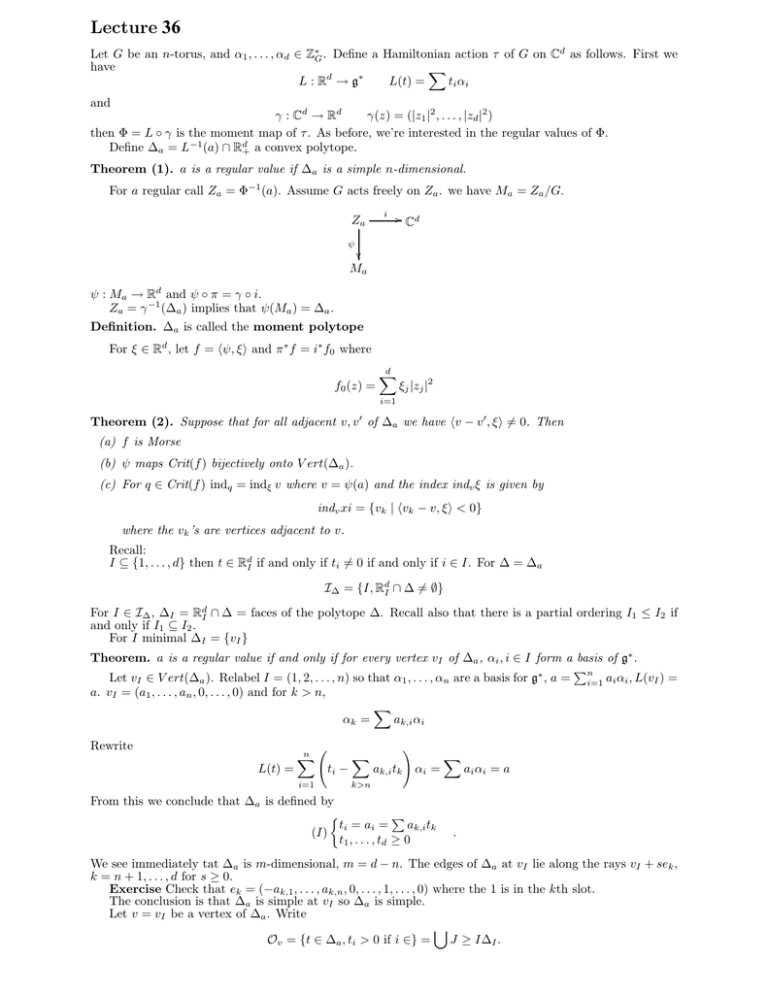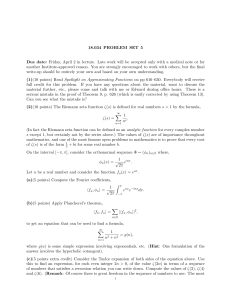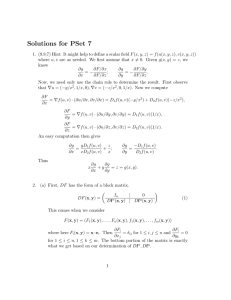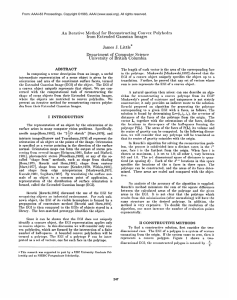36 Lecture
advertisement

Lecture 36
Let G be an n-torus, and α1 , . . . , αd ∈ Z∗G . Define a Hamiltonian action τ of G on Cd as follows. First we
have
�
L : Rd → g ∗
L(t) =
ti αi
and
γ : Cd → Rd
γ(z) = (|z1 |2 , . . . , |zd |2 )
then Φ = L ◦ γ is the moment map of τ . As before, we’re interested in the regular values of Φ.
Define Δa = L−1 (a) ∩ Rd+ a convex polytope.
Theorem (1). a is a regular value if Δa is a simple n-dimensional.
For a regular call Za = Φ−1 (a). Assume G acts freely on Za . we have Ma = Za /G.
i
Za
� Cd
ψ
�
Ma
ψ : Ma → Rd and ψ ◦ π = γ ◦ i.
Za = γ −1 (Δa ) implies that ψ(Ma ) = Δa .
Definition. Δa is called the moment polytope
For ξ ∈ Rd , let f = hψ, ξ i and π ∗ f = i∗ f0 where
f0 (z) =
d
�
i=1
′
ξj |zj |2
6 0. Then
Theorem (2). Suppose that for all adjacent v, v of Δa we have hv − v ′ , ξ i =
(a) f is Morse
(b) ψ maps Crit(f ) bijectively onto V ert(Δa ).
(c) For q ∈ Crit(f ) indq = indξ v where v = ψ(a) and the index indv ξ is given by
indv xi = {vk | hvk − v, ξ i < 0}
where the vk ’s are vertices adjacent to v.
Recall:
I ⊆ {1, . . . , d} then t ∈ RdI if and only if ti 6= 0 if and only if i ∈ I. For Δ = Δa
IΔ = {I, RdI ∩ Δ 6= ∅}
For I ∈ IΔ , ΔI = RdI ∩ Δ = faces of the polytope Δ. Recall also that there is a partial ordering I1 ≤ I2 if
and only if I1 ⊆ I2 .
For I minimal ΔI = {vI }
Theorem. a is a regular value if and only if for every vertex vI of Δa , αi , i ∈ I form a basis of g∗ .
�n
Let vI ∈ V ert(Δa ). Relabel I = (1, 2, . . . , n) so that α1 , . . . , αn are a basis for g∗ , a = i=1 ai αi , L(vI ) =
a. vI = (a1 , . . . , an , 0, . . . , 0) and for k > n,
�
αk =
ak,i αi
Rewrite
L(t) =
n
�
i=1
�
ti −
�
k>n
ak,i tk
�
αi =
From this we conclude that Δa is defined by
�
�
ak,i tk
t = ai =
(I) i
t1 , . . . , td ≥ 0
�
ai αi = a
.
We see immediately tat Δa is m-dimensional, m = d − n. The edges of Δa at vI lie along the rays vI + sek ,
k = n + 1, . . . , d for s ≥ 0.
Exercise Check that ek = (−ak,1 , . . . , ak,n , 0, . . . , 1, . . . , 0) where the 1 is in the kth slot.
The conclusion is that Δa is simple at vI so Δa is simple.
Let v = vI be a vertex of Δa . Write
Ov = {t ∈ Δa , ti > 0 if i ∈} =
J ≥ IΔI .
Consider γ −1 (Ov ). These are open G-invariant sets in Za
Take Uv = π(γ −1 (Ov )) an open cover of Ma . Let f : Ma → R. What does f look like on f |Uv . Take
I = (1, . . . , n) by relabeling. Then
a=
n
�
ai αi
vI = (a1 , . . . , an , 0, . . . , 0)
i=1
then
z∈γ
−1
� 2
|zi | = ai
(vI ) ⇐⇒
zk = 0
i = 1, . . . , n
k>n
Proposition. γ −1 (vI ) is a single G-orbit.
Proof. dim γ −1 (v) = n, dim G = n and G acts freely on γ −1 (v).
More generally, z ∈ Za if and only if γ(z) ∈ Δa . Hence by (I) Ov is defined by
�
|zi |2 = ai −
ak,i |zk |2
and zi =
6 0, i =�1, . . . , n.
Take f0 = ξj |zj |2 then (*)
=c+
�
i∗ f0 = c +
��
k>n
2
∗
ξk −
�
�
ak,i ξi |zk |2
hek , ξi|zk | = π f
k>n
where ek is defined as before.
Proof of Theorem 2. From (∗) the only critical point of f on Uv is a = π(γ −1 (v)).(Recall γ −1 (v) is a single
G-orbit).
Moreover ψ(a) = vI . Finally if p ∈ γ −1 (v), then
�
�
(dπ)∗p (d2 fa ) =
hek , ξi|zk |2 =
hek , ξi(x2k + yk2 )
k>n
k>n
It follows that (d2 fa ) is (....), and the index is 2indξ v.
Also a consequence
H 2k+1 (Ma ) = 0
so
bk = dim H 2k (Ma ) = #{V ert(Δa ), indξ v = k}
and bk = #{indx iv = v} doesn’t depend on ξ. If fk is the number of k-dimensional faces of Δa for
k = 0, . . . , m then
� �
�
�
m
m−1
fm−k =
b0 +
b1 + · · · + bk
k
k−1
Exercise Prove this.
Let Δ be a simple m-dimensional convex polytope and fk be the number of k-dimensional faces of Δ.
Define b0 , . . . , bn by the solutions to the equations
� �
m
fm−k =
b0 + . . . bk
k
Then
Theorem (McMullen, Stanley).
(a) The bk s are integers.
(b) bm−k = bk
(c) b0 ≤ b1 ≤ · · · ≤ bk where k = [ m
2 ].
Proof. Exhibit Δ as the moment polytope of a toric variety of M .
(a) The bk s are Betti numbers of M (so integers)
(b) Poincare duality
(c) Hard Lefschetz.





